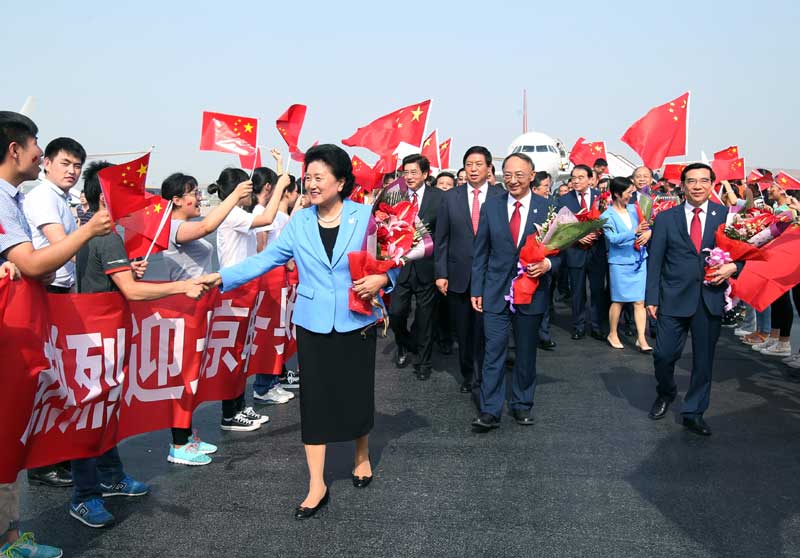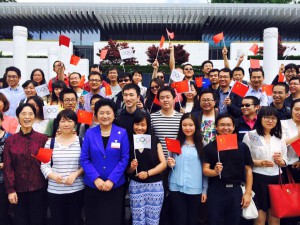Stockholm, Aug. 3(Greenpost)– China has become the world’s largest potato producer, accounting for 25 percent of global production, according to Xinhua News Agency.
The country grew 5.6 million hectares of potato in 2014, yielding in excess of 95 million tonnes, according to the Ministry of Agriculture . China’s potato acreage makes the crop the country’s fourth staple after rice, wheat and corn.
Last year, despite enjoying the 11th consecutive year of bumper grain harvests, the country still imported 71.4 million tonnes of soybean and 19.5 million tonnes of rice, wheat and corn, up 12.7 percent and 33.8 percent, respectively.
With a shortage of farmland in China, the ministry stressed that it is difficult to improve the yield of wheat and rice but easier with potatoes.
It’s hoped that the name of Kingdom of bikes will come back one day when the crazy wave of industrialization ebbs.
More for the following, stay tuned.
China becomes biggest potato producers and consumer
BEIJING, July 29 (Xinhua) — Planting area and output of potato in China each have accounted for about a quarter of the world’s total, making it the biggest potato producer and consumer in the world, according to the 2015 Beijing World Potato Congress and China Potato Expo on Wednesday.
However, per unit area yield and per capita consumption of potato in China are still low, showing the big development potential.
In 2014, the country’s planting area of potato amounted to 5.57 million hectares, accounting for a quarter of the world’s total.
Meanwhile, China yielded more than 95 million metric tons (tonnes) of potato last year, representing a quarter of the world’s total.
Despite the high yields, per unit area yield of potato in China was only 17.7 tonnes per hectare, far lower than that in developed countries.
According to official statistics, per capita consumption of potato in China was only 41.2 kg at present. Enditem
Xinhua Insight: Producers hope potatoes takes root in China
by Xinhua writers Tan Yixiao, Cheng Lu and Wei Mengjia
BEIJING, July 29 (Xinhua) — Potatoes seem like an unlikely ingredient for ice cream, but the allure of tasting the strange concoction had dozens of visitors lining-up at the China Kitchen exhibition at the 2015 World Potato Congress in Beijing.
The 1,000-square-meter stall was serving up to 100 potato-based foods, from noodles to sweet purple drinks, developed by Xisen Potato Industry Co. Ltd., the country’s biggest potato producer. By combining potatoes with traditional Chinese cuisine, the company is at the congress looking for partners to promote their new products being tested at the China Kitchen.
With China promoting potato acreage and encouraging the vegetable as one of the country’s staple foods, more companies like Xisen want to take a bigger slice of the growing market.
Around 500 km away from Beijing, Linkage Potato Co. Ltd., based in Inner Mongolia, China’s major potato production base, is expanding its product portfolio to satisfy people’s appetite.
With five farms and a 70,000-mu (around 4,667 hectares) high standard planting base, the company produces potatoes and seeds and processes potato flakes.
Yan Hongxin, vice president of Linkage, told Xinhua that the company will set up a new production line in autumn to increase its annual output of potato flakes from current 3,000 tonnes to 15,000 tonnes.
In addition, they are eyeing the frozen French fry market as domestic demand grows, driven by expanding fast food chains.
In March this year, it has established a joint venture with Farm Frites, a Dutch enterprise with over 40 years experiences in potato processing, in Wudan Town, Chifeng City in Inner Mongolia.
The new production line will have a capacity of 70,000 tonnes frozen French fries annually with consumption of 140,000 tonnes of fresh potatoes. The fries will be put into the market by 2017 and expansion will continue after that, Yan said.
NO SMALL POTATO
His confidence in the domestic potato market is justifiable.
China is the largest potato producer in the world with a planting area of 5.5 million hectares. However, average Chinese consumption of potatoes is 41.2 kilograms, far below the consumption level of European and American countries, data from China’s Ministry of Agriculture showed.
“Its nutritious value is often overlooked,” said Bi Yang, professor of Gansu Agricultural University.
He pointed out that an average-size potato contains as much protein as an egg, and 10 times more vitamin C than an apple.
With the country’s gross domestic product (GDP) per person surpassed 7,000 U.S. dollars last year, people’s need for improving food nutrition patterns has grown. Bi said potato is a good option to improve nutrition.
In addition, potato is more resistant to the cold and the drought compared with wheat and rice. China is boosting its acreage to make potato as one of the country’s staple foods to better ensure its food security under the pressure of less farmland, water, labor and chemicals.
After years of research, steamed buns made from potato flake made their debut in more than 200 supermarkets in Beijing last month, one step closer to make it a centerpiece of people’s dining table.
LONG WAY TO GO
Seed quality, production cost and eating habits all pose a challenge for potato companies.
Kiremko, a food processing equipment company from the Netherlands, has cooperated with 15 Chinese potato companies for over 30 years.
Joost Miltenburg, area sales manager of Kiremko, said two kilograms of European potato can make one kilogram of French fries with the company’s processing equipment, but some Chinese potatoes fail to produce the same amount of French fries owing to poor quality.
He sees a lot of potential in China but also a lot of waste in potato storage and transportation, inefficient planting and irrigation.
Companies are also seeking ways to lower cost. The potato yield per hectare is 16 tonnes in China, while the number is around 50 tonnes in developed countries, making potato flakes three times more expensive than wheat flour, said Lu Xiaoping, director of International Potato Center’s branch in Asia and the Pacific area.
“Only by establishing a high-tech breeding base and producing in a mechanized way can we guarantee high-quality seeds,” said Liang Xisen, chairman of Xisen Potato Industry Co. Ltd.
But the most difficult problem facing potato companies is to change Chinese people’s long-standing diet habits and give potatoes similar role as rice and wheat.
Miltenburg said Chinese potato noodles and steamed buns are new for him. Although it takes time to change people’s habit, he believes that providing more choices can earn potato fans sooner or later. Enditem







